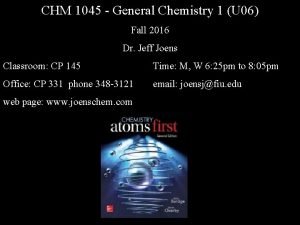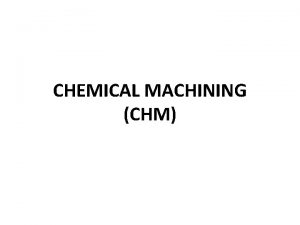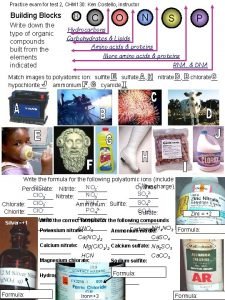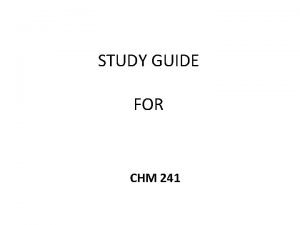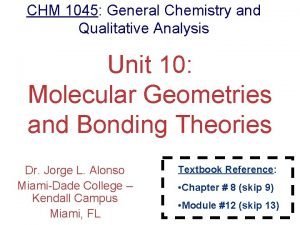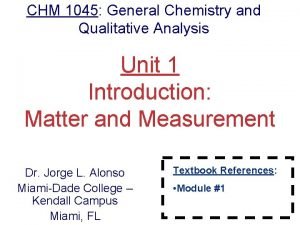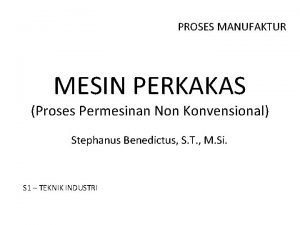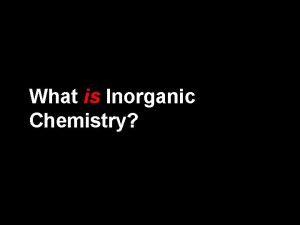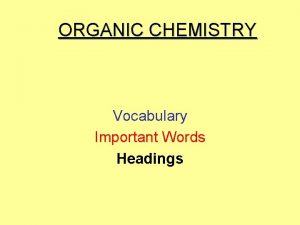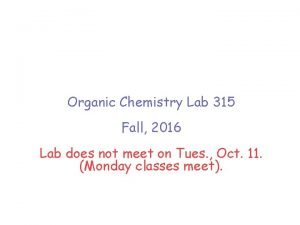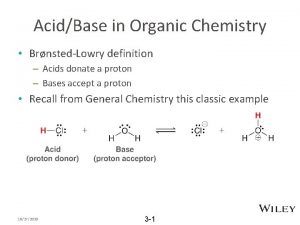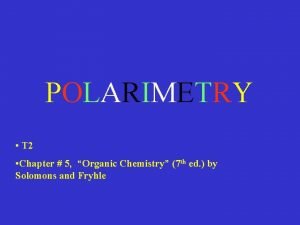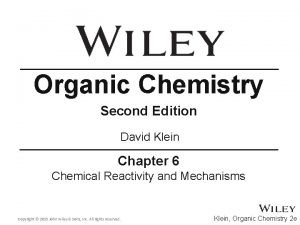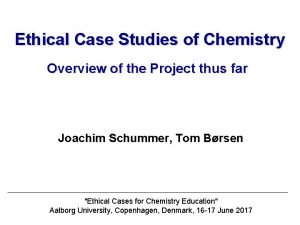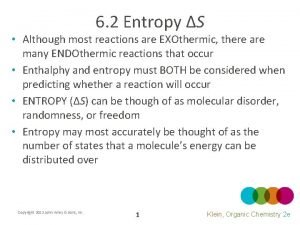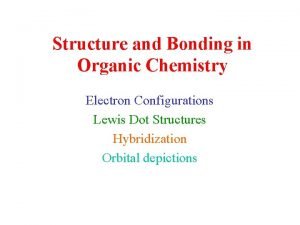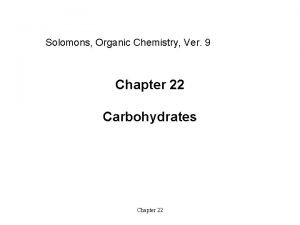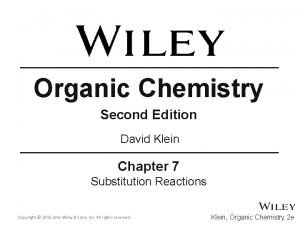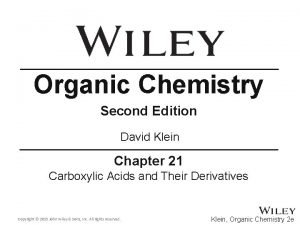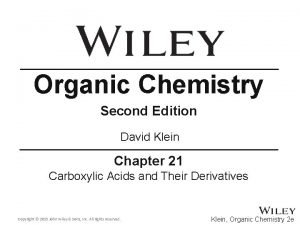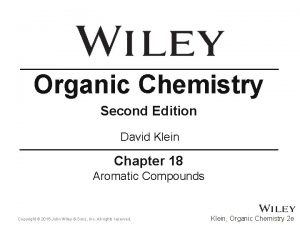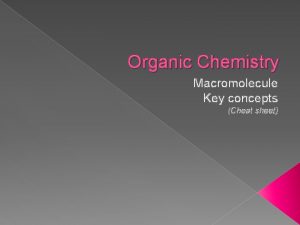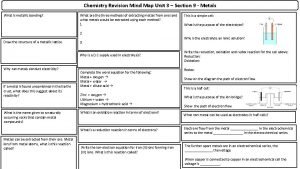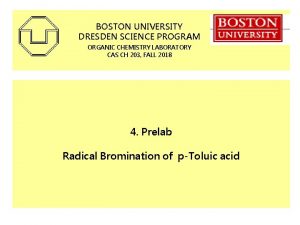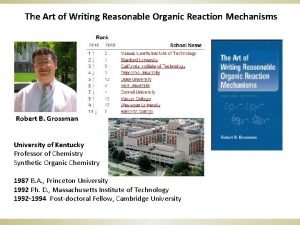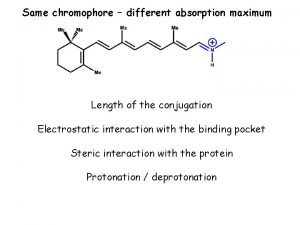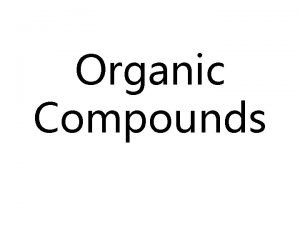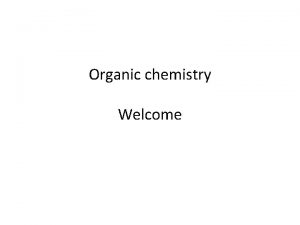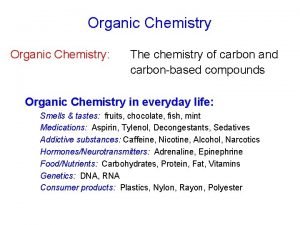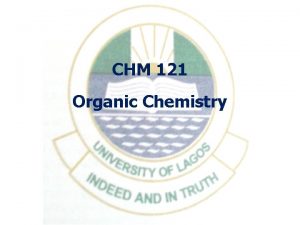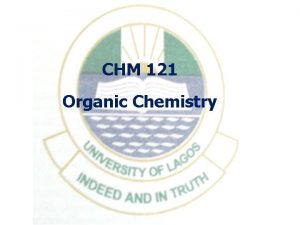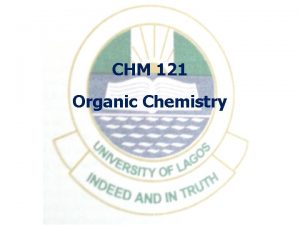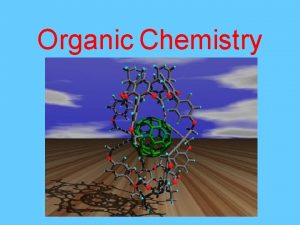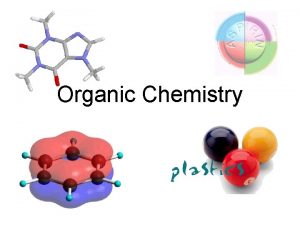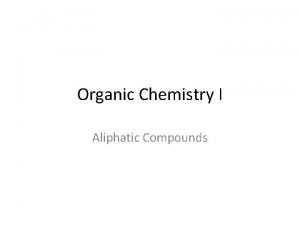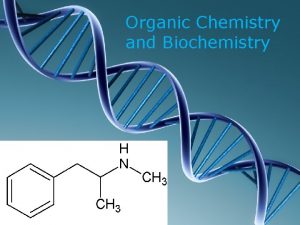Organic Chemistry I CHM 201 William A Price




























![Formal Charges Formal charge = [group number ] – [nonbonding electrons ] – ½ Formal Charges Formal charge = [group number ] – [nonbonding electrons ] – ½](https://slidetodoc.com/presentation_image_h/9feeef61bfedc07c9ca7d3c336353db0/image-29.jpg)












![Solved Problem 2 Draw the important resonance forms for [CH 3 OCH 2]+. Indicate Solved Problem 2 Draw the important resonance forms for [CH 3 OCH 2]+. Indicate](https://slidetodoc.com/presentation_image_h/9feeef61bfedc07c9ca7d3c336353db0/image-42.jpg)








































- Slides: 82

Organic Chemistry I CHM 201 William A. Price, Ph. D. price@lasalle. edu

Structure and Bonding Atomic structure Lewis Structures Resonance Structural Formulas Hybridization



Electronic Structure of the Atom • An atom has a dense, positively charged nucleus surrounded by a cloud of electrons. • The electron density is highest at the nucleus and drops off exponentially with increasing distance from the nucleus in any direction. Chapter 1 5

Orbitals are Probabilities

2 s Orbital Has a Node


The 2 p Orbitals • There are three 2 p orbitals, oriented at right angles to each other. • Each p orbital consists of two lobes. • Each is labeled according to its orientation along the x, y, or z axis. Chapter 1 9

p x, p y , p z

Electronic Configurations • The aufbau principle states to fill the lowest energy orbitals first. • Hund’s rule states that when there are two or more orbitals of the same energy (degenerate), electrons will go into different orbitals rather than pairing up in the same orbital. Chapter 1 11

Electronic Configurations of Atoms • Valence electrons are electrons on the outermost shell of the atom. Chapter 1 12

Covalent Bonding • Electrons are shared between the atoms to complete the octet. • When the electrons are shared evenly, the bond is said to be nonpolar covalent, or pure covalent. • When electrons are not shared evenly between the atoms, the resulting bond will be polar covalent. Chapter 1 13

Bonding in H 2 The Sigma (s) Bond

Sigma Bonding • Electron density lies between the nuclei. • A bond may be formed by s—s, p—p, s—p, or hybridized orbital overlaps. • The bonding molecular orbital (MO) is lower in energy than the original atomic orbitals. • The antibonding MO is higher in energy than the atomic orbitals. Chapter 2 15

s and s* of H 2

Molecular Orbitals Mathematical Combination of Atomic Orbitals

Antibonding Molecular Orbital Destructive Overlap Creates Node

Lewis Dot Structure of Methane

Tetrahderal Geometry

Lewis Structures CH 4 Carbon: 4 e 4 H@1 e ea: 4 e 8 e NH 3 Nitrogen: 5 e 3 H@1 e ea: 3 e 8 e H 2 O Cl 2 Oxygen: 6 e 2 H@1 e ea: 2 e 8 e 2 Cl @7 e ea: 14 e Chapter 1 21

Bonding Patterns C Valence electrons (group #) 4 # Bonds # Lone Pair Electrons 4 0 N 5 3 1 O 6 2 2 Halides 7 1 3 (F, Cl, Br, I) Chapter 1 22


Bonding Characteristics of Period 2 Elements

Lewis structures are the way we write organic chemistry. Learning now to draw them quickly and correctly will help you throughout this course. Chapter 1 25

Multiple Bonding • Sharing two pairs of electrons is called a double bond. • Sharing three pairs of electrons is called a triple bond. Chapter 1 26


Convert Formula into Lewis Structure • • HCN HNO 2 CHOCl C 2 H 3 Cl N 2 H 2 O 3 HCO 3 C 3 H 4
![Formal Charges Formal charge group number nonbonding electrons ½ Formal Charges Formal charge = [group number ] – [nonbonding electrons ] – ½](https://slidetodoc.com/presentation_image_h/9feeef61bfedc07c9ca7d3c336353db0/image-29.jpg)
Formal Charges Formal charge = [group number ] – [nonbonding electrons ] – ½ [shared electrons] H 3 O+ NO+ 6 – 2 – ½ (6) = +1 + 5 – 2 – ½ (6) = 0 + • Formal charges are a way of keeping track of electrons. • They may or may not correspond to actual charges in the molecule. Chapter 1 29

Common Bonding Patterns Chapter 1 30

Work enough problems to become familiar with these bonding patterns so you can recognize other patterns as being either unusual or wrong. Chapter 1 31

Nitromethane has 2 Formal Charges

Both Resonance Structures Contribute to the Actual Structure

Dipole Moment reflects Both Resonance Structures

Resonance Rules • Cannot break single (sigma) bonds • Only electrons move, not atoms 3 possibilities: – Lone pair of e- to adjacent bond position • Forms p bond - p bond to adjacent atom - p bond to adjacent bond position

Curved Arrow Formalism Shows flow of electrons

Resonance Forms • The structures of some compounds are not adequately represented by a single Lewis structure. • Resonance forms are Lewis structures that can be interconverted by moving electrons only. • The true structure will be a hybrid between the contributing resonance forms. Chapter 1 37

Resonance Forms Resonance forms can be compared using the following criteria, beginning with the most important: 1. Has as many octets as possible. 2. Has as many bonds as possible. 3. Has the negative charge on the most electronegative atom. 4. Has as little charge separation as possible. Chapter 1 38

Two Nonequivalent Resonance Structures in Formaldehyde

Major and Minor Contributors • When both resonance forms obey the octet rule, the major contributor is the one with the negative charge on the most electronegative atom. MAJOR MINOR The oxygen is more electronegative, so it should have more of the negative charge. Chapter 1 40

Resonance Stabilization of Ions Pos. charge is “delocalized”
![Solved Problem 2 Draw the important resonance forms for CH 3 OCH 2 Indicate Solved Problem 2 Draw the important resonance forms for [CH 3 OCH 2]+. Indicate](https://slidetodoc.com/presentation_image_h/9feeef61bfedc07c9ca7d3c336353db0/image-42.jpg)
Solved Problem 2 Draw the important resonance forms for [CH 3 OCH 2]+. Indicate which structure is the major and minor contributor or whether they would have the same energy. Solution The first (minor) structure has a carbon atom with only six electrons around it. The second (major) structure has octets on all atoms and an additional bond. Chapter 1 42

Solved Problem 3 Draw the resonance structures of the compound below. Indicate which structure is the major and minor contributor or whether they would have the same energy. Solution Both of these structures have octets on oxygen and both carbon atoms, and they have the same number of bonds. The first structure has the negative charge on carbon, the second on oxygen. Oxygen is the more electronegative element, so the second structure is the major contributor. Chapter 1 43

Resonance Forms for the Acetate Ion • When acetic acid loses a proton, the resulting acetate ion has a negative charge delocalized over both oxygen atoms. • Each oxygen atom bears half of the negative charge, and this delocalization stabilizes the ion. • Each of the carbon–oxygen bonds is halfway between a single bond a double bond and is said to have a bond order of 1½. Chapter 1 44

Condensed Structural Formulas Lewis 1 Condensed 2 • Condensed forms are written without showing all the individual bonds. • Atoms bonded to the central atom are listed after the central atom (CH 3, not H 3 CCH 3). • If there are two or more identical groups, parentheses and a subscript may be used to represent them. Chapter 1 45

Drawing Structures

Octane Representations

Line-Angle Structures are Often Used as a Short-hand

Line-Angle Structures


Line-Angle structure Superimposed on Lewis Structure

Line-Angle Drawings 1 2 3 4 5 1 6 2 3 4 5 6 • Atoms other than carbon must be shown. • Double and triple bonds must also be shown. Chapter 1 52


For Cyclic Structures, Draw the Corresponding Polygon

Drawing Clear Structures

Some Steroids

For CARBON, In the Ground State 2 bonding sites, 1 lone pair

sp 3 Hybridization 4 Regions of electron Density link

Hybridization of 1 s and 3 p Orbitals gives 4 sp 3 Orbitals

sp 3 is Tetrahedral Geometry Methane

Methane Representations

Ammonia Tetrahedral Geometry Pyramidal Shape

All Have the Same Geometry All Have 4 Regions of Electron Density All are sp 3 Hybridized

Orbital Depiction of Ethane, C 2 H 6 , the s bond

Rotation of Single Bonds • Ethane is composed of two methyl groups bonded by the overlap of their sp 3 hybrid orbitals. • There is free rotation along single bonds. Chapter 2 65

Isomerism • Molecules that have the same molecular formula but differ in the arrangement of their atoms are called isomers. • Constitutional (or structural) isomers differ in their bonding sequence. • Stereoisomers differ only in the arrangement of the atoms in space. Chapter 2 66

Constitutional Isomers • Constitutional isomers have the same chemical formula, but the atoms are connected in a different order. • Constitutional isomers have different properties. • The number of isomers increases rapidly as the number of carbon atoms increases. Chapter 2 67

sp 2 Hybridization 3 Regions of Electron Density

Hybridization of 1 s and 2 p Orbitals – sp 2

An sp 2 Hybridized Atom

Ethylene CH 2=CH 2


Rotation Around Double Bonds? • Double bonds cannot rotate. • Compounds that differ in how their substituents are arranged around the double bond can be isolated and separated. Chapter 2 73

Geometric Isomers: Cis and Trans • Stereoisomers are compounds with the atoms bonded in the same order, but their atoms have different orientations in space. • Cis and trans are examples of geometric stereoisomers; they occur when there is a double bond in the compound. • Since there is no free rotation along the carbon–carbon double bond, the groups on these carbons can point to different places in space. Chapter 2 74

Formaldehyde – C and O both sp 2 hybridized


sp Hybridization 2 Regions of Electron Density

The sp Orbital

Acetylene, C 2 H 2, 1 s bond 2 perpendicular p bonds

Molecular Shapes • Bond angles cannot be explained with simple s and p orbitals. • Valence-shell electron-pair repulsion theory (VSEPR) is used to explain the molecular shape of molecules. • Hybridized orbitals are lower in energy because electron pairs are farther apart. Chapter 2 80

Summary of Hybridization and Geometry Hybrid Orbitals (# of s bonds) Hybridization Geometry Approximate Bond Angle 2 s + p = sp linear 180⁰ 3 s + p = sp 2 trigonal 120⁰ 4 s + p + p = sp 3 tetrahedral 109. 5⁰ Chapter 2 81

Solved Problem 2 Borane (BH 3) is not stable under normal conditions, but it has been detected at low pressure. (a) Draw the Lewis structure for borane. (b) Draw a diagram of the bonding in this molecule, and label the hybridization of each orbital. (c) Predict the H–B–H bond angle. Solution There are only six valence electrons in borane. Boron has a single bond to each of the three hydrogen atoms. The best bonding orbitals are those that provide the greatest electron density in the bonding region while keeping the three pairs of bonding electrons as far apart as possible. Hybridization of an s orbital with two p orbitals gives three sp 2 hybrid orbitals directed 120° apart. Overlap of these orbitals with the hydrogen 1 s orbitals gives a planar, trigonal molecule. (Note that the small back lobes of the hybrid orbitals have been omitted. ) Chapter 2 82
 Chm 201
Chm 201 Cis-2 3-dimethyloxirane
Cis-2 3-dimethyloxirane Ib organic chemistry
Ib organic chemistry Inorganic vs organic chemistry
Inorganic vs organic chemistry Upang mapatatag ang presyo sa pamilihan
Upang mapatatag ang presyo sa pamilihan Chemistry 151 final exam
Chemistry 151 final exam Chm 1045
Chm 1045 Chemical blanking
Chemical blanking Chm 130 chapter 12 practice problems answer key
Chm 130 chapter 12 practice problems answer key Chm 241
Chm 241 Chm 1045
Chm 1045 Chm 111
Chm 111 Chm machining
Chm machining Smc ptk
Smc ptk Chm logo
Chm logo Founder of organic chemistry
Founder of organic chemistry Soap organic chemistry
Soap organic chemistry Ester organic chemistry
Ester organic chemistry Examples of isomers in chemistry
Examples of isomers in chemistry Transition state energy diagram
Transition state energy diagram Ee organic chemistry
Ee organic chemistry Ario organic chemistry
Ario organic chemistry Pericyclic
Pericyclic Organic chemistry david klein 3rd edition
Organic chemistry david klein 3rd edition Organic chemistry 2nd edition klein
Organic chemistry 2nd edition klein What is the leveling effect organic chemistry
What is the leveling effect organic chemistry Organic chemistry naming
Organic chemistry naming Organic chemistry lab report example
Organic chemistry lab report example Www.masterorganicchemistry.com
Www.masterorganicchemistry.com Organic chemistry grade 10
Organic chemistry grade 10 Organic chemistry
Organic chemistry Importance of organic compounds
Importance of organic compounds Kiliani fischer synthesis
Kiliani fischer synthesis Crash course organic chemistry
Crash course organic chemistry How is cracking done
How is cracking done Organic and biochemistry
Organic and biochemistry Organic chemistry myanmar
Organic chemistry myanmar Electrophilic addition hbr
Electrophilic addition hbr M+1 peak
M+1 peak Hono organic chemistry
Hono organic chemistry Father of organic chemistry
Father of organic chemistry Topic 11 organic chemistry
Topic 11 organic chemistry Chapter 22 review organic chemistry section 1 answers
Chapter 22 review organic chemistry section 1 answers Organic chemistry reaction pathways
Organic chemistry reaction pathways Organic chemistry nomenclature
Organic chemistry nomenclature What is organic chemistry like
What is organic chemistry like Organic vs inorganic molecules
Organic vs inorganic molecules Organic chemistry vocabulary
Organic chemistry vocabulary Organic chemistry (3rd) edition chapter 1 problem 20s
Organic chemistry (3rd) edition chapter 1 problem 20s Organic chemistry laboratory ch 2540 manual
Organic chemistry laboratory ch 2540 manual A level chemistry ocr organic synthesis
A level chemistry ocr organic synthesis Importance of lipids
Importance of lipids Ario acidity
Ario acidity Calculate percentage yield
Calculate percentage yield Polarimetry organic chemistry
Polarimetry organic chemistry Organic chemistry third edition david klein
Organic chemistry third edition david klein Organic chemistry
Organic chemistry Hammonds postulate
Hammonds postulate Organic chemistry second edition david klein
Organic chemistry second edition david klein Organic chemistry chapter 9
Organic chemistry chapter 9 Chemistry ethics case studies
Chemistry ethics case studies Chapter 7 organic chemistry
Chapter 7 organic chemistry Entane
Entane Analytical chemistry chapters
Analytical chemistry chapters Hammond's postulate organic chemistry
Hammond's postulate organic chemistry Octane lewis structure
Octane lewis structure Conformation of sugars ppt
Conformation of sugars ppt Resonance in benzyl carbocation
Resonance in benzyl carbocation Organic chemistry
Organic chemistry Organic chemistry
Organic chemistry Organic chemistry
Organic chemistry Organic chemistry
Organic chemistry Organic chemistry cheat sheet
Organic chemistry cheat sheet Chemistry mind map
Chemistry mind map Ethos
Ethos Bu organic chemistry
Bu organic chemistry Organic chemistry
Organic chemistry Conjugation organic chemistry
Conjugation organic chemistry Organic chemistry
Organic chemistry Alkyl group example
Alkyl group example Which allotrope of carbon feels greasy and crumbles easily?
Which allotrope of carbon feels greasy and crumbles easily? Halohydrin formation
Halohydrin formation C6h14 structural isomers
C6h14 structural isomers






